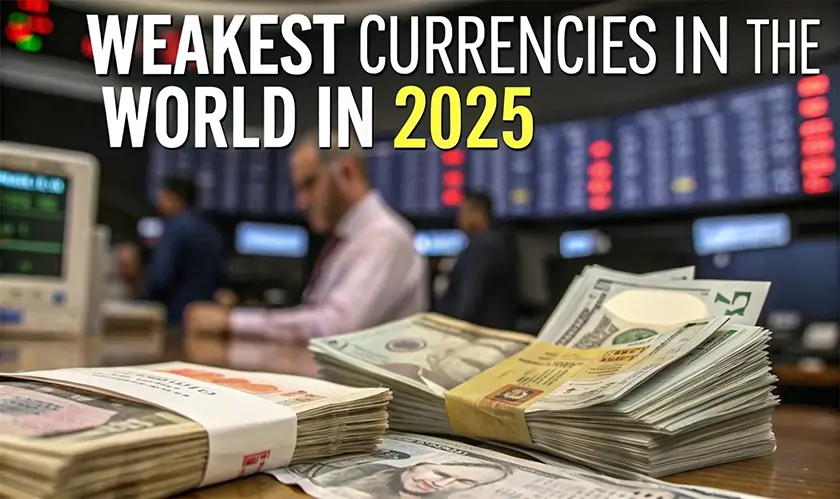Home Platforms News Weakest Currencies in the Worl...
News

CIO Bulletin
22 August, 2025
The world currencies convey the mettle and stability of the economy. Where robust currencies such as the US dollar, euro, or pound sterling command world trade, numerous others simply fight to maintain value owing to economic turbulence, political unrest, and ineffective financial systems. Some foreign currencies are falling behind as we push towards the year 2025 with the lowest money value and exchange rates. The meaning of these cases is that economic issues may diminish national currencies and affect world trade.
A weak currency can be explained as one with low buying power and with a poor exchange rate as compared to stronger currencies such as the US dollar. Inflation, excessive debt, or extended political instability can weaken a nation's currency. This weakness discourages foreign investment, increases import prices and erodes citizens' spending too. A couple of currencies are now synonymous with economic turmoil and among the weakest in the world.
The Iranian rial has remained as one of the weakest currencies in the world in 2025. The Iranian economy has suffered greatly under years of international sanctions, restrictions on the export of oil products and tedious international relations. Hyperinflation and a significant discrepancy between the official and parallel rates have led to an intensive depreciation of the rial. This situation translates into the higher prices of basic products for ordinary citizens and challenges for businesses to acquire imports. The rial is an example of what isolation in trade with global markets and political issues combined can do to the money value of a currency.
The Vietnamese dong is one more foreign currency that also regularly appears on the list of weakest currencies. Despite the growth of Vietnam's manufacturing industry and its integration into global supply chains, the value of the dong remains very low compared to the US dollar. The government has a policy of keeping the currency undervalued to spur exports, and this long-term policy means that in nominal terms, the dong will be one of the weakest currencies in the world in 2025. The economy is stable and expanding, but the extreme exchange rate of the dong indicates how monetary policy can maintain a currency at low rates.
Inflation, the nature of imports and dependence, and exposure to the vagaries of world economic forces has battered Sierra Leone. The country has been heavily depending on the export of minerals especially diamonds, hence making its currency at the mercy of international commodity forces. Political uncertainty and a lack of industrial diversification have exacerbated the state of economic turmoil. By 2025, the leone is one of the weakest currencies in the world, as it barely holds firm. Citizens find purchasing power lower and basic needs become more costly, thus putting more pressure on household incomes.
The Laotian kip is one of the least valued currencies in the world. Laos has structural economic issues such as high debts and excess emphasis on hydropower exports. The kip is weak due to less industrialization and few foreign investments. Recently, inflation and debt servicing pressures have further eroded confidence in the currency. The kip remains one of the lowest valued currencies by 2025 as it struggles to find a balance between domestic and international financial issues.
The Guinea franc is also the indicator of a weak economy that focuses on mineral exports like bauxite and gold. Political instability, corruption, and lack of developed infrastructure have not helped Guinea stabilize its financial system. Consequently, the franc also has a low value against the stronger world currencies. In 2025, the state of affairs has not changed, and the franc also enters the list of weakest world currencies. To businesses, such weakness translates to less availability of cheap imports and continuous inflationary pressure, making economic growth all the more complicated.
In these illustrations, several common factors cause currencies to plummet to their lowest value. One of the most detrimental is high inflation, which will lower the purchasing power of the citizens and shake up exchange rates. Political insecurity is a third factor that creates fear among foreign investors and undermines local banks. Dependence on only one product of export, like oil or minerals also makes the currencies vulnerable to external shocks. Coupled with this, smaller economies have heavy external debts, which leave them short of resources and overly reliant on superior foreign currencies.
Weak currencies have effects not only within their countries. Countries operating with devalued currencies can enjoy export prices being competitive, but the imports will cost them more. Foreigners hate investing in markets with unstable currencies; thus, foreign capital inflows are limited. Transactions with such currencies carry with them complications for international travelers and businesses, such as fluctuating exchange rates and uncertainties in transaction values. The resilience of the weaker global currencies in 2025 portrays the separation between wealthy financial centers and doomed economies.
Weak currencies are challenges, but even these are lessons in survival and renewal. Countries with historically cheap currencies can recover by enhancing financial regulation and by diversifying their economies and encouraging stable investments. Policies that seek to control inflation, reduce dependence on imports, etc., can be used to restore confidence. Moreover, incorporating international trade systems more deeply can act as a substitute for stability in currency realignment. The examples of foreign currencies performing poorly in 2025 point to the fact that the weak currency is not indefinite but directly tied to governance, policy, and global interconnection.
The weakest currencies in the world in 2025 are an indication of the complicated nature of the economics, politics, and trade. Consider the Iranian rial and Vietnamese dong compared to the leone, kip, and franc; all are opportunities to gauge how structural vulnerabilities, financial turmoil and tinkering policies can drive a currency toward the scariest units of money. This results in reduced purchasing power for citizens, as well as increased restrictions on business operations and access to nations worldwide. However, such currencies can stabilize in the future with strong reforms and improved financial policies. Until that time, they are a lesson to the shaky equilibrium of the world financial system.
FAQs
Investors tend to avoid weak currencies due to their instability, preferring to invest in more stable economies.
Yes, strong governance, reforms, decreased inflation, and international aid can help currencies go a long way.







